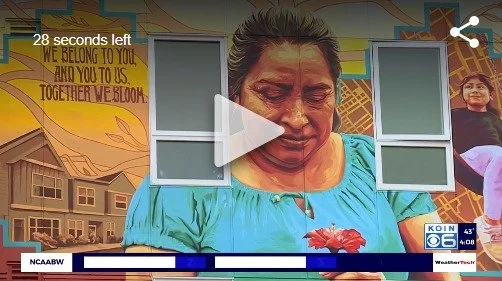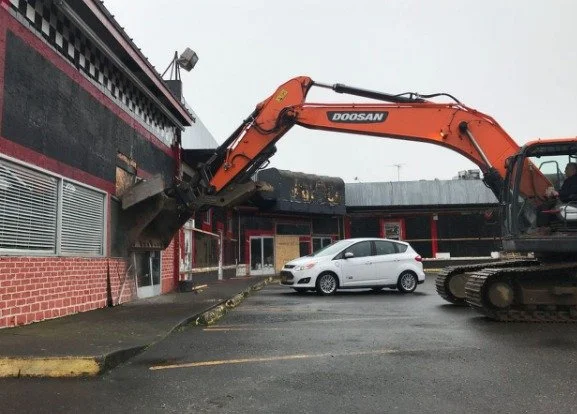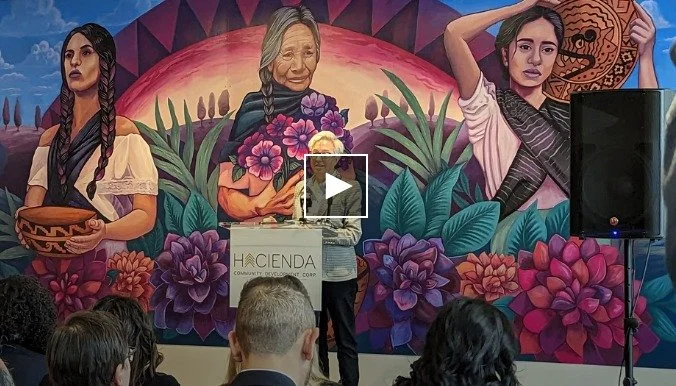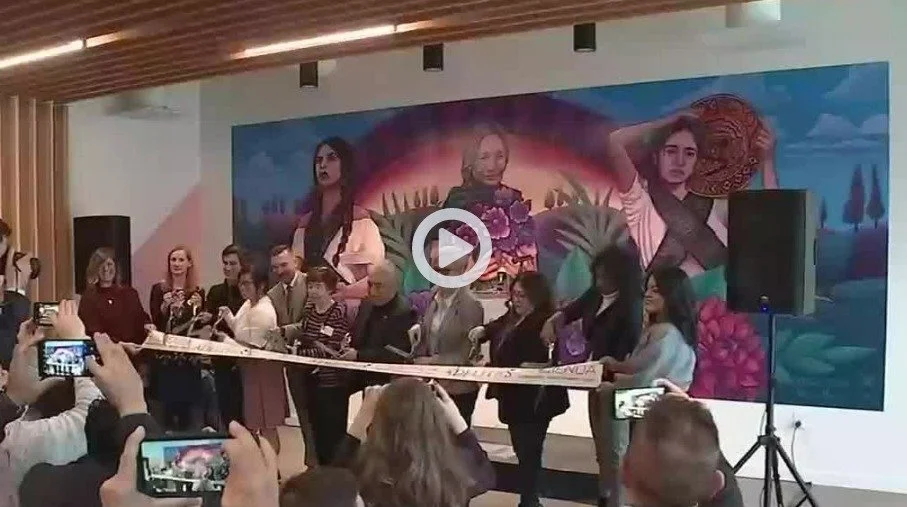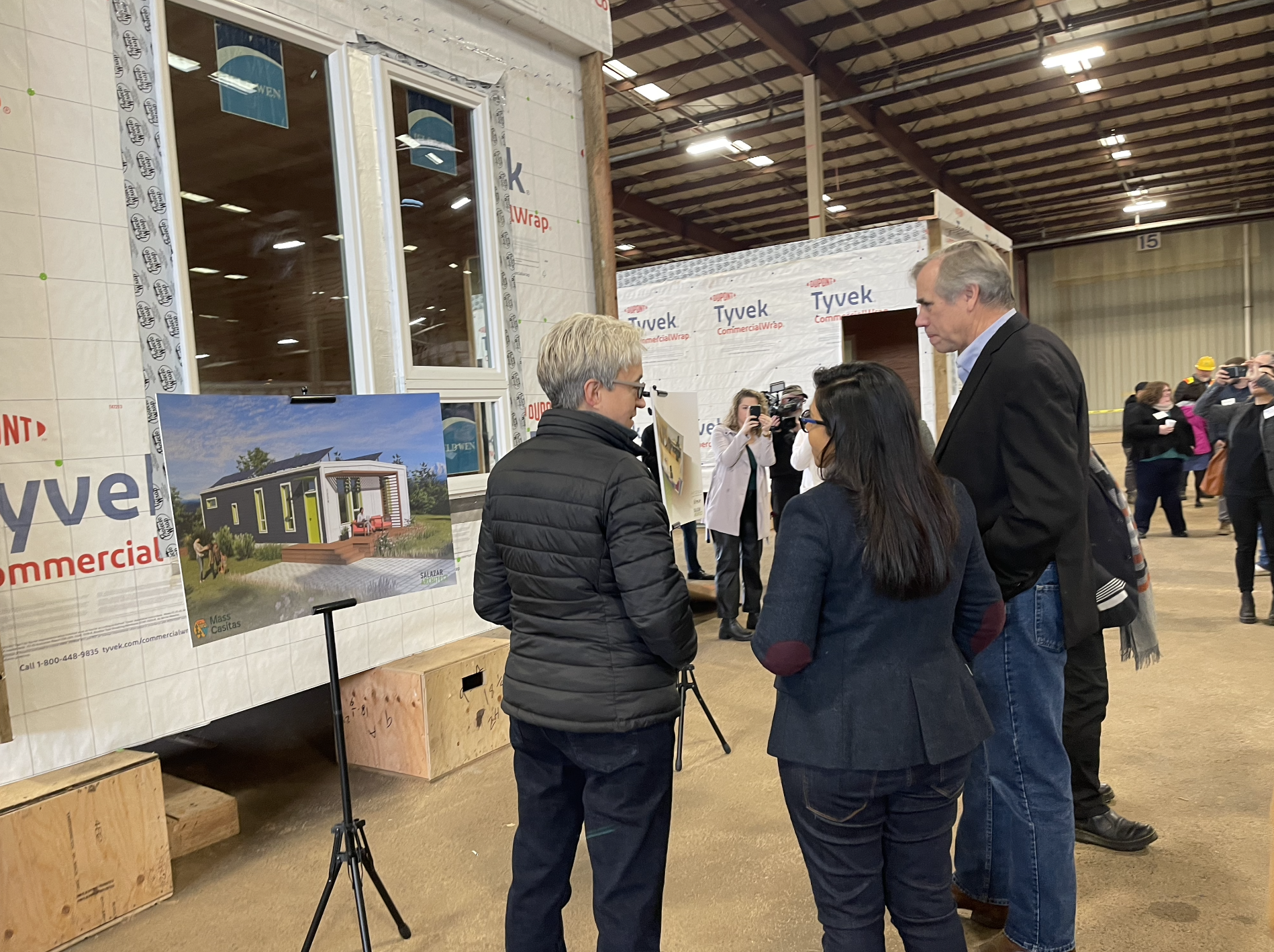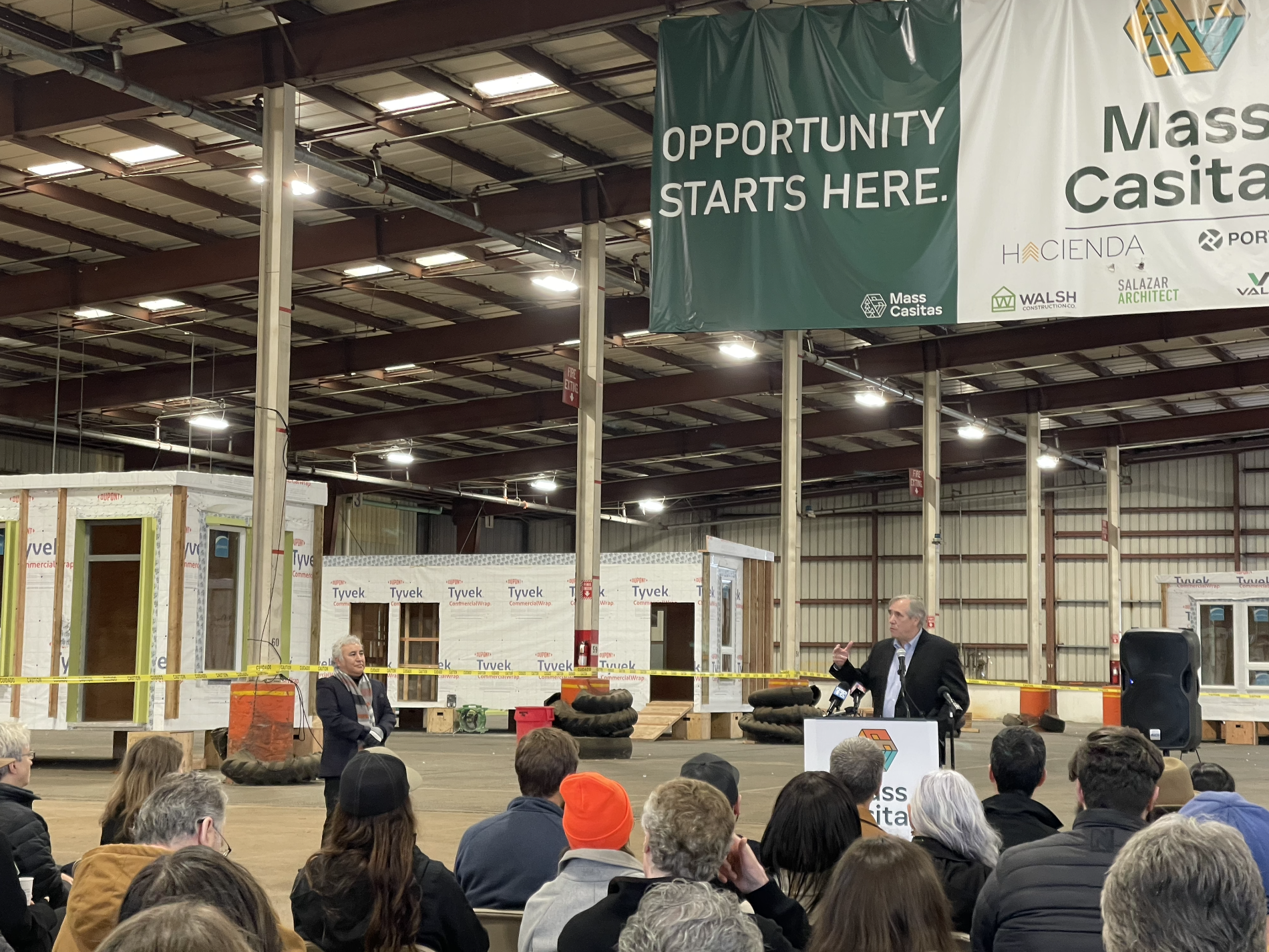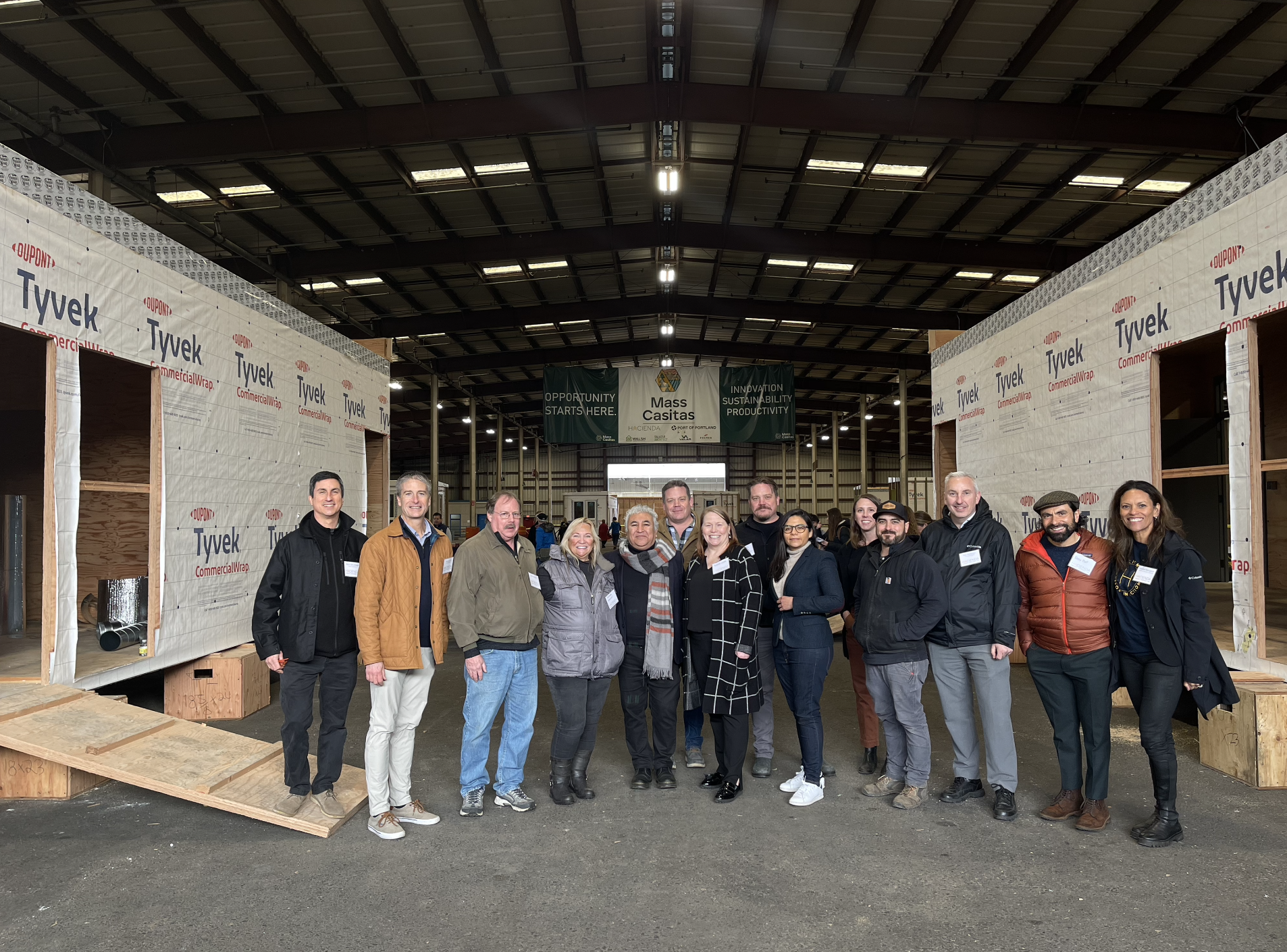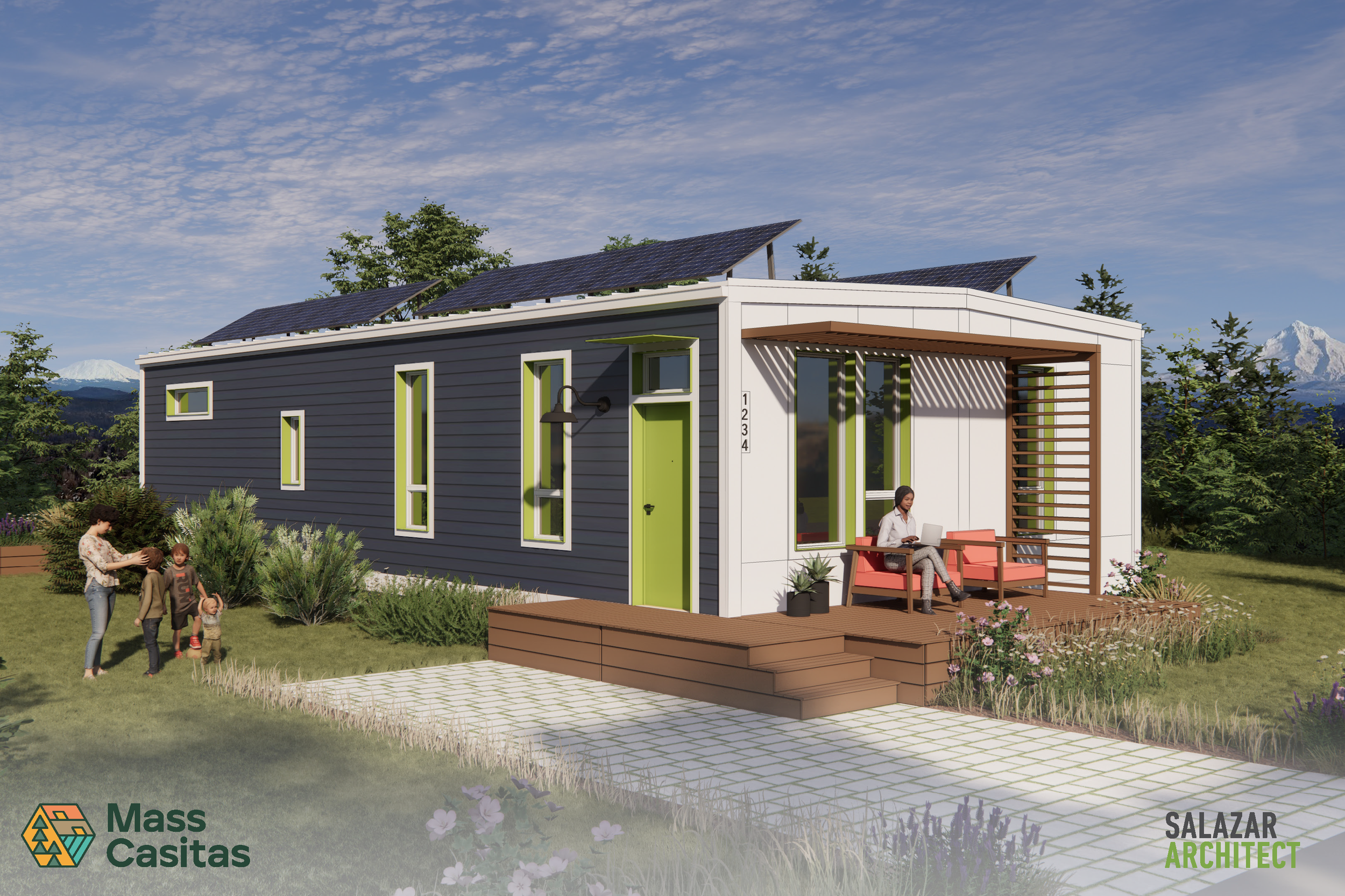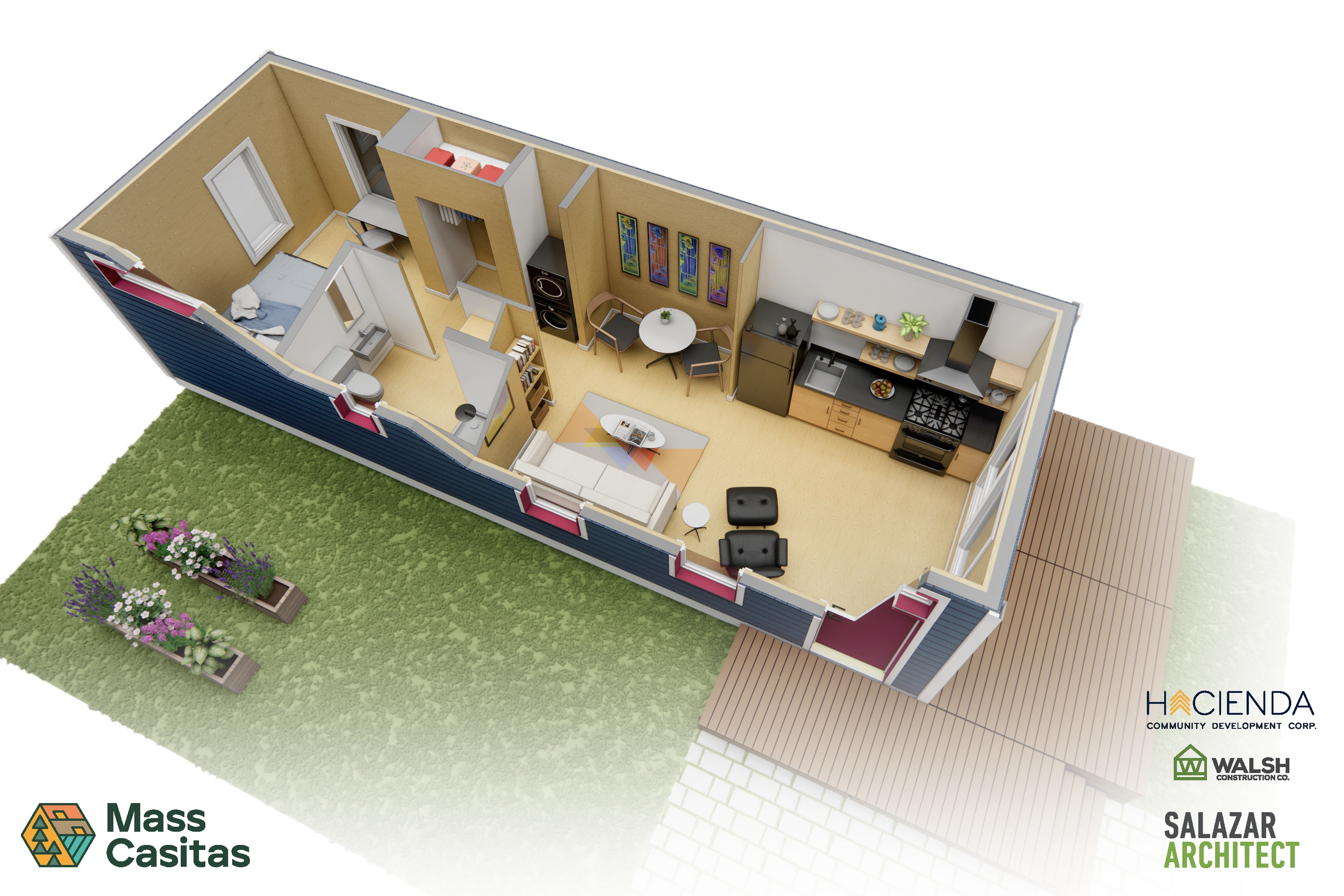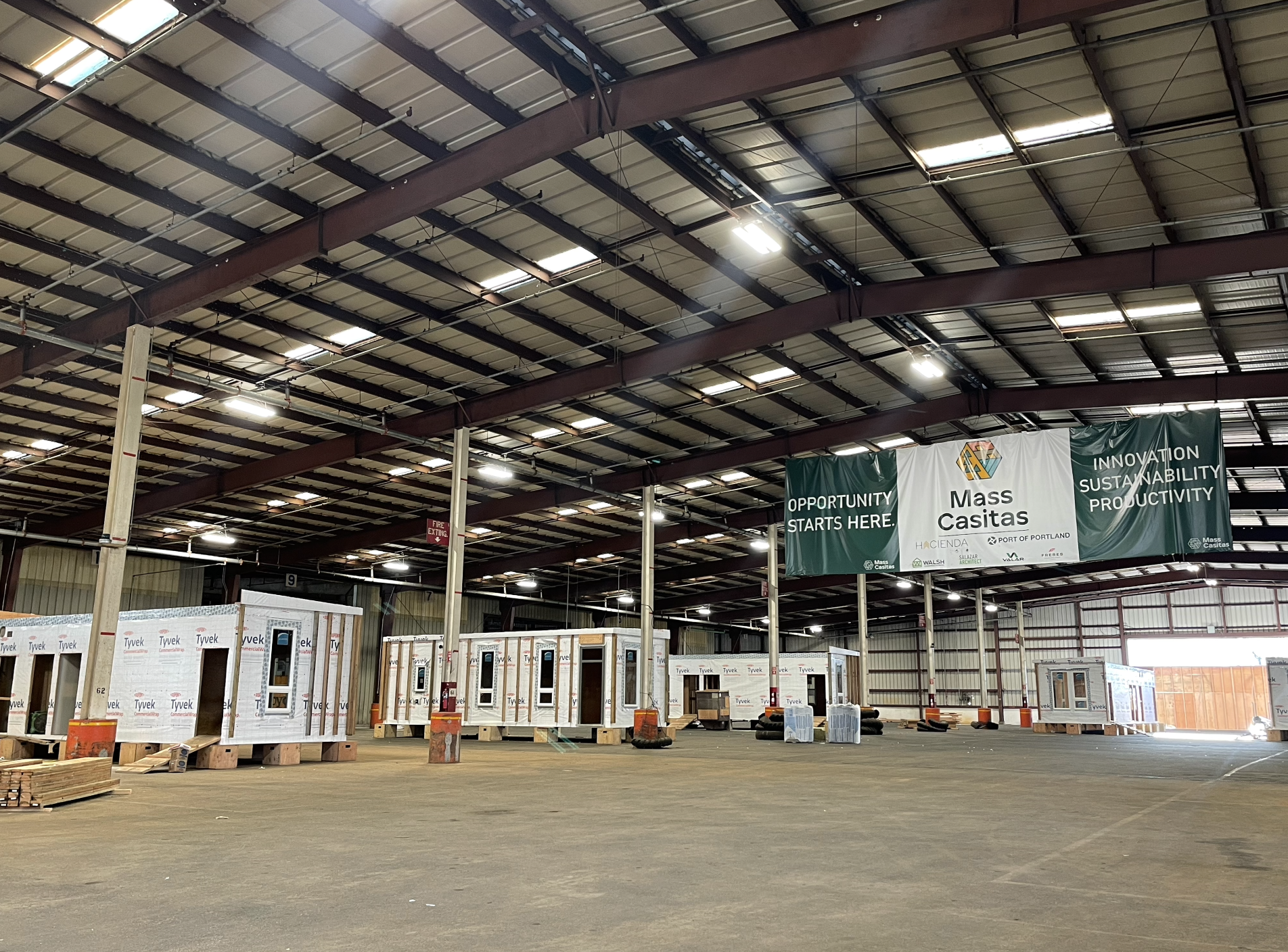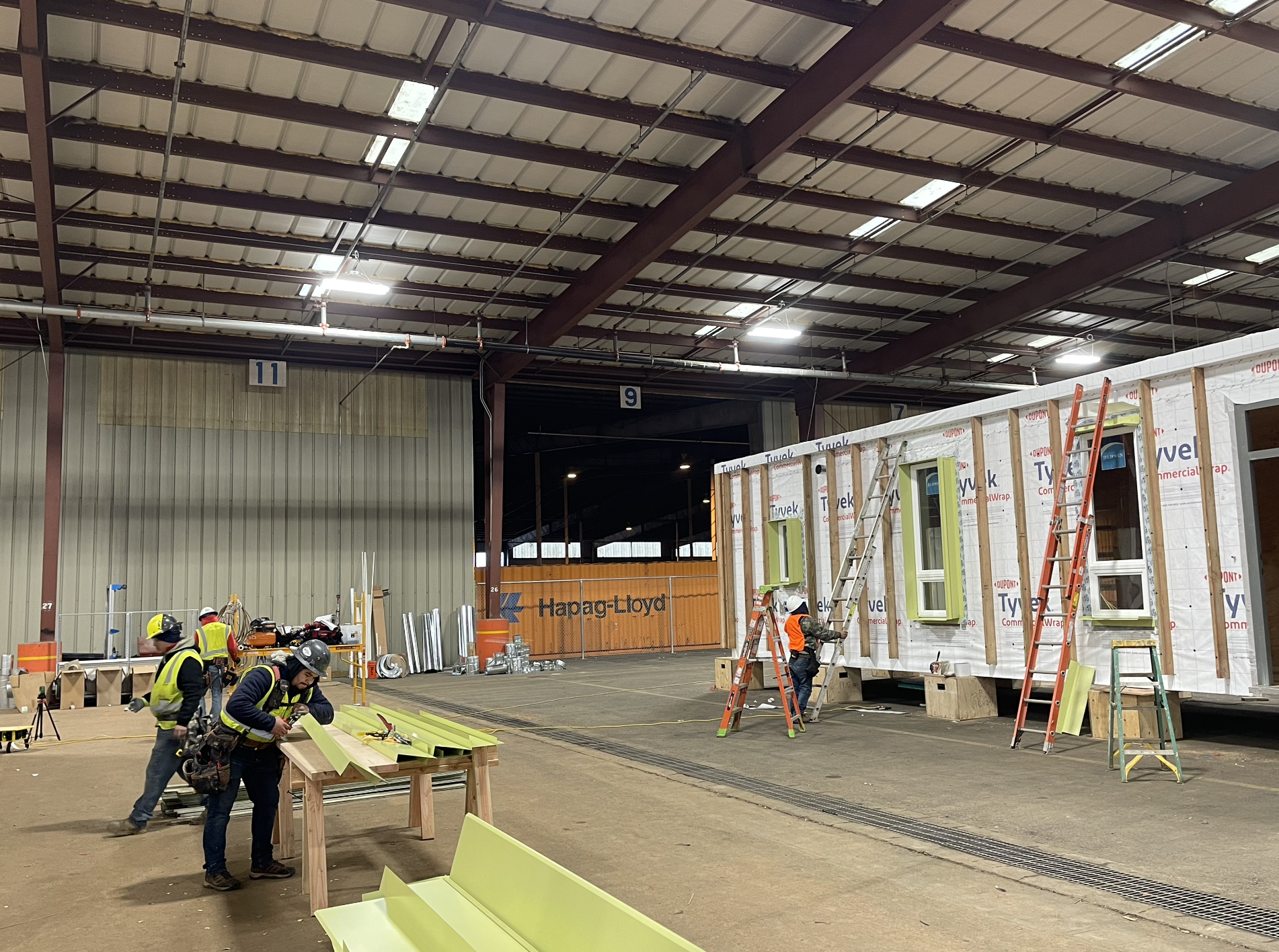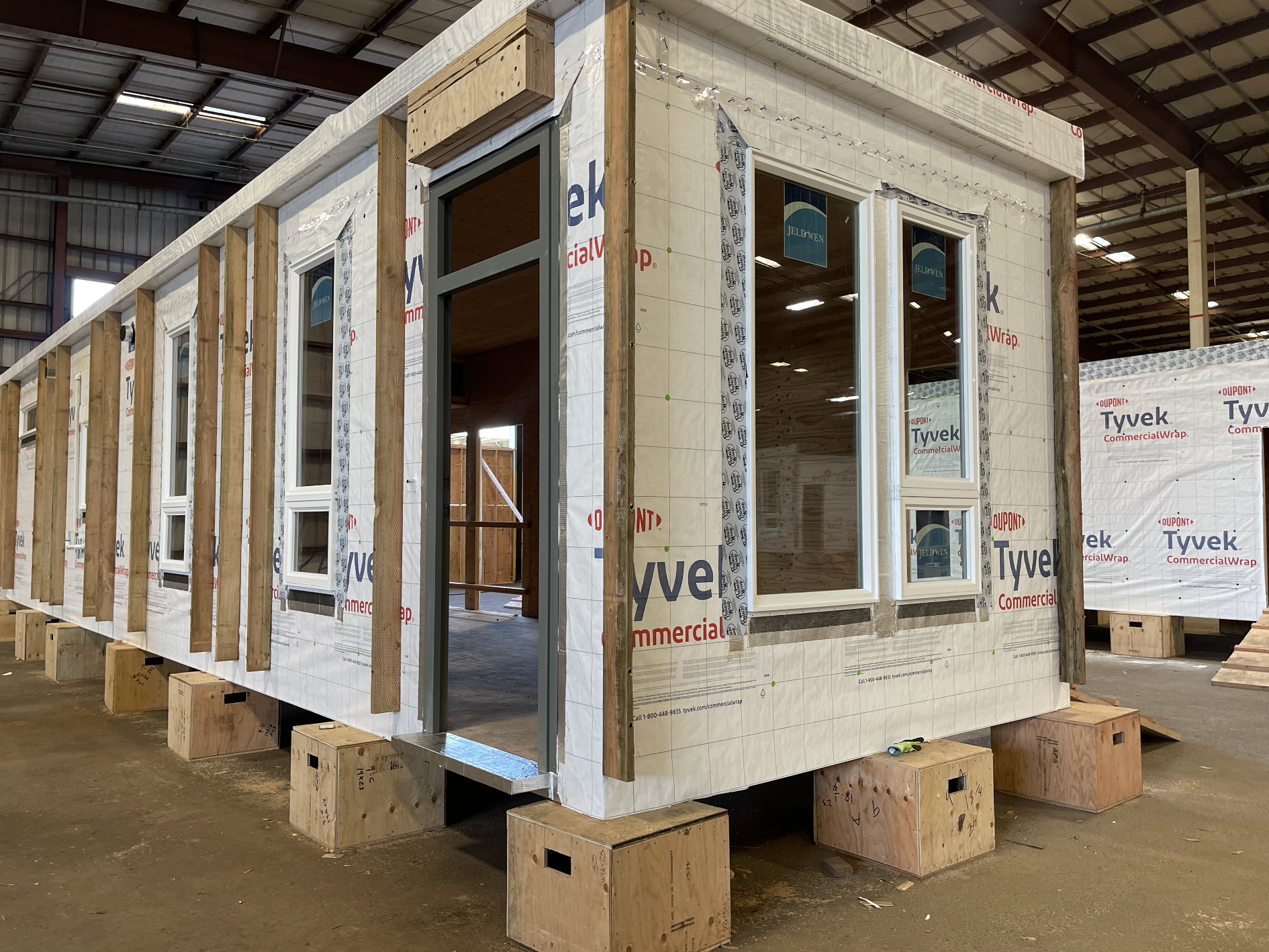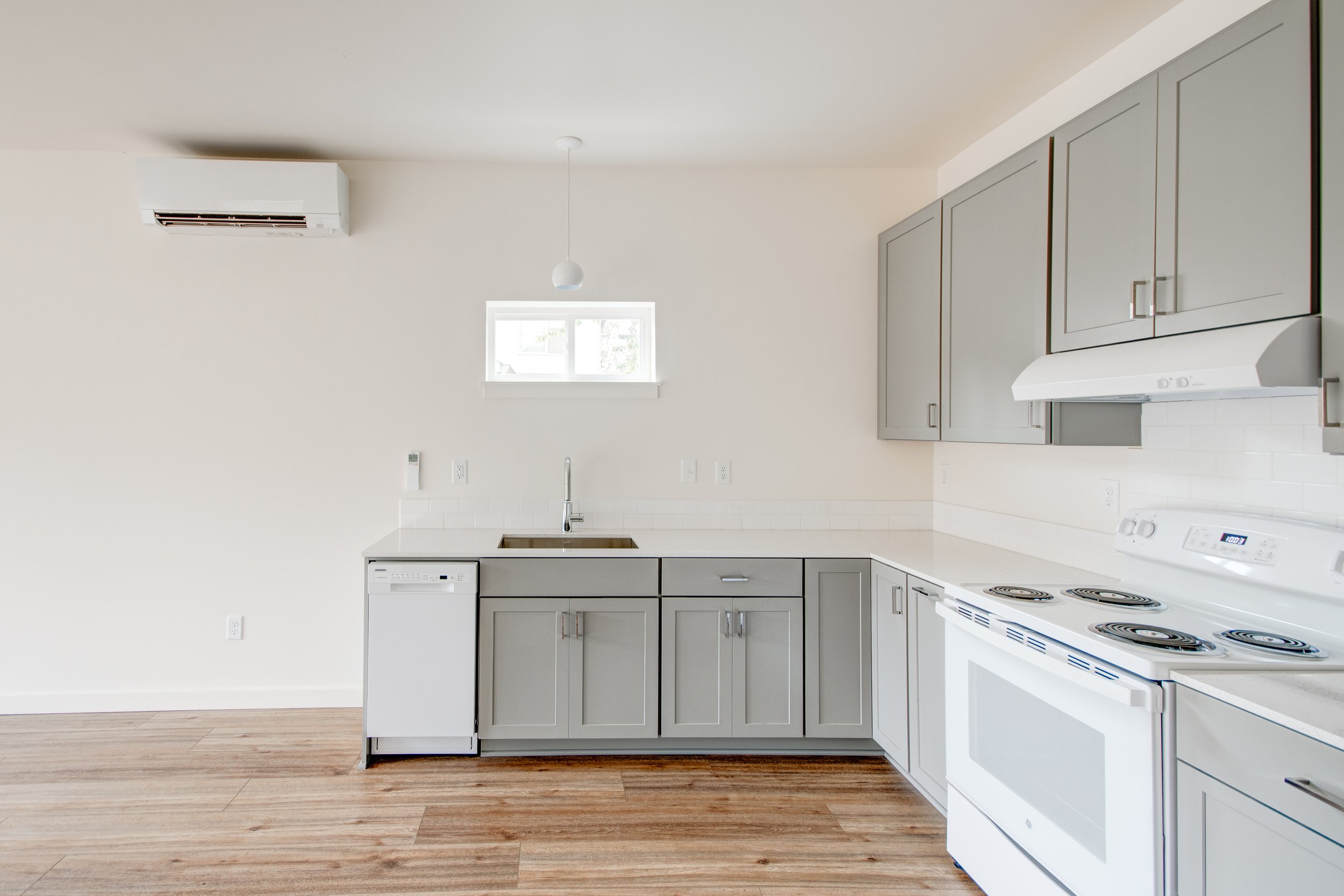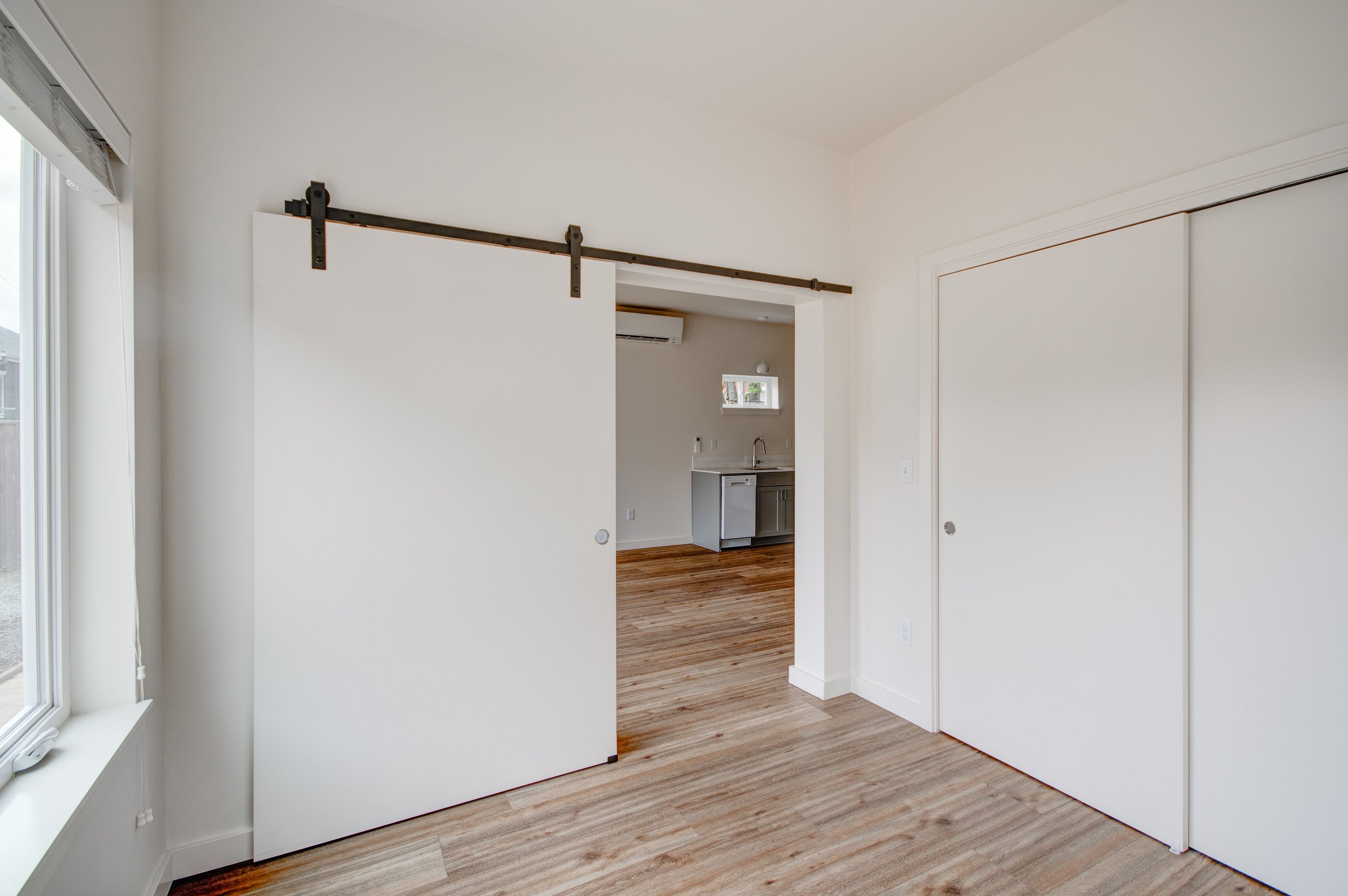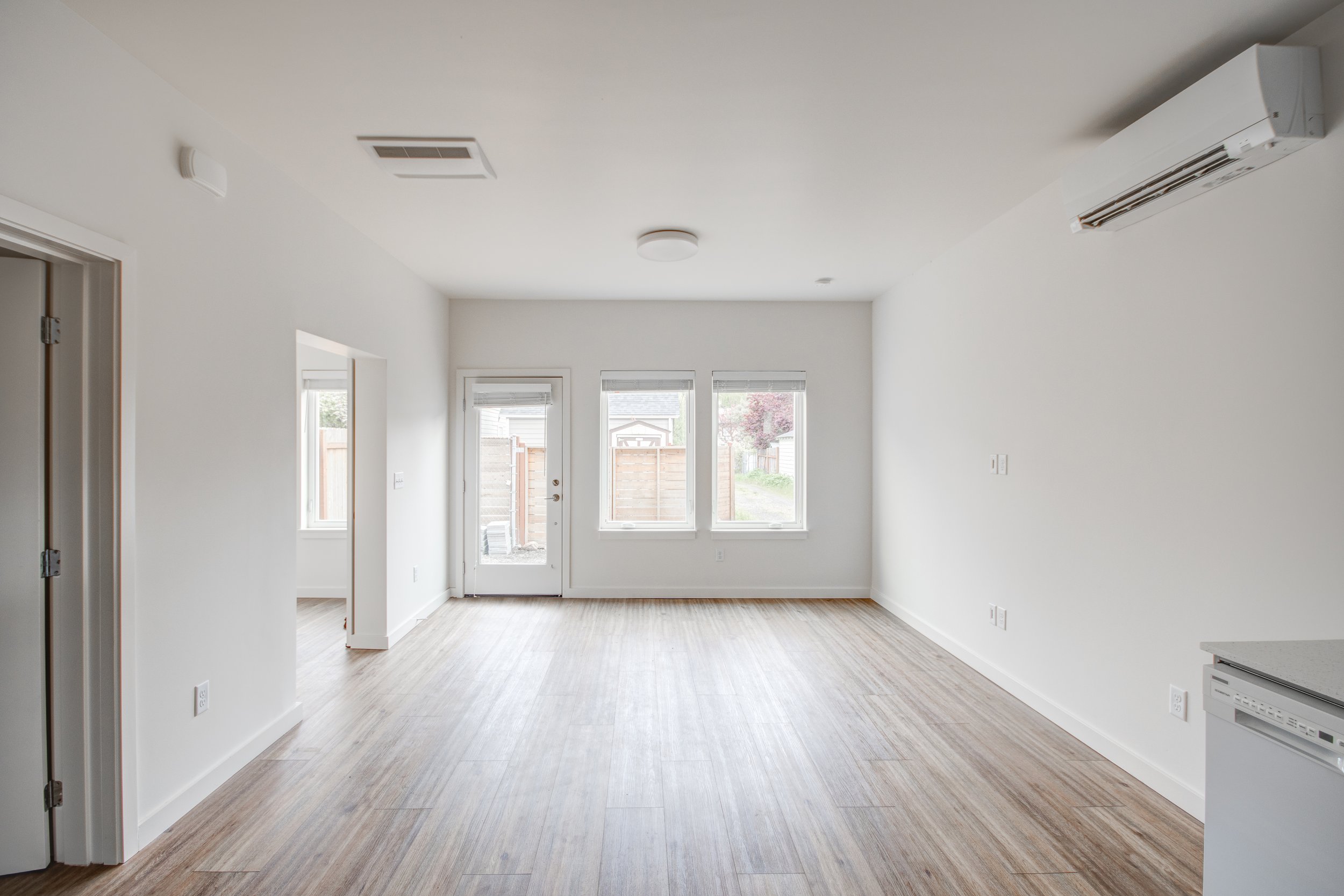Construction is underway on six prototype homes headed to Oregon communities this summer
PORTLAND, Ore.— Inside a sprawling warehouse at the Port of Portland’s Terminal 2, a potential solution to ease Oregon’s housing shortage is swiftly taking shape. Workers are assembling six prototype modular homes using Oregon-produced mass timber that will soon house pre-selected families and individuals in four communities (Madras, Otis, Portland and Talent). Led by Hacienda CDC, the pilot project (among the first of its kind in the nation) aims to demonstrate how modular housing built with mass timber could provide a more efficient, faster and less expensive way to build housing. The pilot was spearheaded by $5 million in funding from the Oregon Legislature.
On Friday, Hacienda offered a first look at the prototype homes, called Mass Casitas, to city and state officials, including Oregon Governor Tina Kotek and Senator Jeff Merkley, community leaders, and the media at the Port of Portland’s Marine Terminal 2.
“We need more homes now to address Oregon’s urgent housing crisis, and traditional systems alone will not be enough to get the job done. Mass Casitas is innovative because we’re combining mass timber with modular single-family home construction to develop a process that could help Oregon add more high-quality housing, faster,” said Ernesto Fonseca, CEO of Hacienda.
State economists have said that Oregon has a shortage of 110,000 housing units for current residents at all income levels. To accommodate future growth, the state may need to build more than 580,000 homes by 2040. The greatest need is among residents with the lowest incomes.
“I was excited to advocate for $5 million dollars to support this vision in its infancy, and I’m thrilled today to see its first major step forward. The Mass Casitas project is proof that, together, we can act with the urgency people across our state are demanding. Bold ideas, concrete solutions, disciplined follow through. That’s how we can deliver results,” said Kotek.
The vision of Mass Casitas extends beyond housing, Fonseca said. With additional public and private investment, the model has the potential to accelerate the growth of Oregon’s mass timber industry and create new jobs — and in the process, help to revitalize former logging communities and increase economic opportunities for Oregonians, especially in rural communities and communities of color.
Visitors who toured the Mass Casitas production site on Friday saw the six prototype homes under construction. Once complete, the homes will be donated and delivered to nonprofit organizations in four Oregon communities by June 2023. The nonprofits will select which individuals and families will live in the homes.
The six prototype homes (which range in size between 1-3 bedrooms) are headed for these four Oregon communities:
1 home is going to Madras (Jefferson County); partner is Casa of Oregon
1 home is going to Otis (Lincoln County); partner is Cascade Relief Team
2 homes are going to Portland (Multnomah County); partner is Community Vision
2 homes are going to Talent (Jackson County); partner is Casa of Oregon
Following delivery of the prototypes, the Mass Casitas team will monitor how the homes perform in different climates and their utility to residents, using what they learn to improve the design, inform the production process and assess the potential of creating the units at scale.
"Mass Casitas is helping transform Terminal 2 into a site for innovation, mass timber industry transformation, and opportunity for Oregon families," said Keith Leavitt, chief trade & equitable development officer at the Port of Portland. "This project is even more evidence that mass timber can be transformative for Oregon, and it's full of opportunity for those who have been left behind, from new housing options to the creation of good-paying jobs along the timber and housing construction supply chain."
During the December 2021 special session, the Legislature allocated $5 million for Mass Casitas to the Port of Portland, which is providing the warehouse space and fund management and partnered with Hacienda, the housing organization leading the project. Other key team members are: Salazar Architect Inc. (design), Walsh Construction Co. (general contractor), VALAR Consulting Engineering (engineering), and Freres Engineered Wood (mass timber supplier/expert).
###
About Hacienda CDC
Hacienda CDC is a trusted Latino/x-led community-building organization that strengthens BIPOC and low-income communities through affordable housing and holistic services for adults, families and youth. Founded in 1986 in Portland’s Cully neighborhood, Hacienda has grown to support underserved communities that face barriers to opportunity throughout urban and rural Oregon. Through our own innovative approaches and high-impact partnerships, Hacienda develops affordable housing and provides client-centered services and programs that enable people to thrive and achieve their dreams of home ownership, entrepreneurship and education. Learn more at haciendacdc.org.
Learn more about Mass Casitas and this Innovative solution to address the housing crisis
Portland, OR - Hacienda Community Development Corporation (CDC) is pleased to announce that the first residents have moved into Las Adelitas, the organization's newest affordable housing development.
Located at the corner of Killingsworth Street and Cully Boulevard in Portland’s Cully neighborhood, Las Adelitas includes 142 affordable rental apartments and a community event space. The development is designed to meet the needs of low-income families and individuals, with a mix of efficiency, one-, two-, and three-bedroom apartments as well as amenities such as a playground, bike storage, electric vehicle car-sharing, and a solar buyback program. The complex was designed with community in mind through various community-led workshops that spoke to the needs of families and individuals.
Applications opened September 2022 and are open on a rolling basis for individuals and families that fall below 60% of the area median income.
Las Adelitas is the outcome of a 5+ year community-driven process to transform a former vacated lot that was negatively impacting the vitality of Cully. After a grassroots effort from community and various supporters, in 2015, Hacienda, Verde, and Habitat for Humanity came together to form the coalition, Living Cully to buy the property with the support of CRAFT3, Prosper Portland, Oregon Community Fund, Meyer Memorial Trust, over $50,000 donated directly from community members, and many others. In 2017 Hacienda purchased the entire property to create affordable housing that is so desperately needed.
Aptly named after feminist Mexican revolutionaries, the building brings deep social, economic and environmental benefits to the Cully community. Inspired by community design in every detail, the community also features a large-scale mural by notable artist Michelle Angela Ortiz which features Cully community members and a poem written by a local neighbor.
First resident to Las Adelitas receives keys from Ernesto Fonseca, Hacienda Chief Executive Officer
"We are thrilled to welcome the first residents to Las Adelitas," said Chief Executive Officer, Ernesto Fonseca. "This development was once just a dream, and many people thought it couldn’t be done, now we are welcoming our first residents and celebrating it as an important step in our efforts to provide affordable housing options for low-income families and individuals in the Portland area."
In addition to affordable housing, Las Adelitas also includes a community event space and space for Portland Niños, Hacienda’s program for families with children age 0-5.
Hacienda will be celebrating the official grand opening of Las Adelitas in early Spring. For more information about Las Adelitas and our full list of funders, please visit www.lasadelitas.org.
##
The 171-unit community from Hacienda CDC and Community Development Partners is designed for a diverse group of residents of all ages to thrive
Oregon City’s newest community is swiftly taking shape, bringing 171 units of much-needed affordable rental housing with integrated on-site services and support. With a special focus on serving larger families and older residents; agricultural workers employed nearby; and adults and children at risk for or transitioning out of homelessness, the Las Flores development reflects the reality that Oregon’s housing challenges affect a diverse mix of residents in smaller suburbs, cities and towns beyond Portland and Salem. The community expects to welcome its first residents in summer 2023.
This is the second community that is co-owned and co-developed by Hacienda Community Development Corporation (Hacienda CDC), an Oregon-based, Latino-led community building organization with a holistic approach and client-centered services, and Community Development Partners (CDP), a mission-driven affordable housing developer. Together they are helping to fill Oregon’s need for affordable housing with a model that goes beyond providing a roof over people’s heads.
“Las Flores will be more than apartments. This will be a community that provides what individuals and families need to find stability and reach their goals,” said Ernesto Fonseca, CEO, Hacienda CDC. “This will be a place where residents can find after-school and summer programming for their kids, start on a path to buying a home through homeownership counseling, or connect with small business advising.”
“The affordable housing shortage burdens our smaller, more rural areas too, so we’re excited to be taking our successful partnership with Hacienda CDC beyond Portland to serve the diverse communities who live and work in Oregon City and Clackamas County,” said Eric Paine, CEO, CDP. “Las Flores will not only offer a beautiful place to live, but a place where individuals and families can connect and build community.”
The key ingredients of the CDP-Hacienda partnership that make Las Flores a different kind of affordable housing community include:
Community-informed from the start. Before design or construction began, CDP and Hacienda engaged with Salazar Architect and the Center for Public Interest Design (CPID) at Portland State University to conduct a thorough survey of assets and challenges in the surrounding area. This included many meetings with Oregon City community members and organizations, whose input shaped the design of buildings and other spaces at Las Flores and the kinds of services and support that will be available to residents.
A physical campus that promotes health and well-being for all ages. Las Flores has been designed using the people-first, “Communities for All Ages” (CFAA) approach, which embraces the benefits of intergenerational living and creates homes and spaces where all people can be respected, cared for, and given tools to explore their interests. This includes buildings clustered around a park-like gathering space, tree-dotted walking paths, children’s play areas, outdoor picnic areas, a community garden, and a community building with a kitchen and multi-use spaces where residents can hold events, take classes, and enjoy spending time with their families and neighbors.
Integrated on-site services that support families and help them move ahead. As co-developer, Hacienda will offer on-site services to Las Flores residents that help them thrive and pursue goals like getting on the path to homeownership or building a brighter future by starting their own business — including after-school and early childhood education, homeownership counseling, and small business advising.
Significant funding for Las Flores comes from Clackamas County’s share of the Metro Regional Affordable Housing Bond, approved by voters in 2018.
“Across this region, we are in the middle of multiple housing crises,” said Metro Councilor Christine Lewis, who represents District 2, which includes Oregon City. “It may look and feel a little different than downtown Portland, but we're part of all the same problems. We have a lack of affordability, we have homelessness. We have folks who are getting displaced from their current housing and they don't know where to turn.”
Location and residents
At Las Flores, seven attractive, high-quality apartment buildings will encircle a wide-open green space and a community building for events and classes. The 4.5 acre site is northeast of Highway 213 and South Beavercreek Road, where dense retail and housing on Oregon City’s eastern border begin to give way to farmland and rural areas of Clackamas County.
”Achieving the housing progress we seek as a state must mean shared progress for Oregon’s farmworkers and their families,” said Andrea Bell, Director of Oregon Housing and Community
Services (OHCS). “Our economies and communities are strongest when everyone has their basic needs met — this centers our humanity as a state and upholds self-determination, human dignity and respect. Las Flores is yet another manifestation of what is possible when all of us come together in service to our communities.”
Las Flores is designed for low-income families and individuals in the Oregon City area, who are the least likely to find housing they can afford:
Las Flores’ mix of unit sizes (from one to four bedrooms) will allow for small and large households and residents of all ages, especially important given the region’s shortage of 3- and 4-bedroom units.
Residents must earn 30% to 60% of the area median income (in Clackamas County, that’s $31,950 to $63,900 for a family of four).
12 units will be set aside for people who work in the agricultural industry and their families, including those who work on farms, in nurseries, at dairies and on reforestation projects. Clackamas County has the sixth-largest population of migrant and agricultural workers in the state, according to state figures.
9 units will be permanent supportive housing, with services provided by Northwest Housing Alternatives. Those units will be reserved for families transitioning out of NHA’s Annie Ross House in Milwaukie. Nearly 600 people are experiencing homelessness in Clackamas County, and more than 300 of them are unsheltered, according to the most recent Point-In-Time count.
“Through NHA’s Annie Ross family shelter program, we are grateful to have the opportunity at Las Flores to facilitate new affordable housing for families transitioning from homelessness,” shared Trell Anderson, Executive Director of Northwest Housing Alternatives. “Our established working relationship with Hacienda CDC in resident services will translate into seamless programming, long-term housing stability, and support for kids, for all the families making the Las Flores development their home.”
Las Flores is funded by a 4% Low Income Housing Tax Credit (LIHTC) allocation with equity investment by Aegon, OHCS Market Cost Offset Funds, Clackamas County’s share of the Metro Regional Affordable Housing Bond Funds administered by the Housing Authority of Clackamas County, Agriculture Workforce Housing Tax Credits, and a Section 8 contract for 70 project-based vouchers. Construction financing is being provided by US Bank and permanent financing is being provided by Citi. The project was designed by Salazar Architect and is being built by LMC Construction. Guardian Management will be the property manager.
Video note: CDP and Hacienda CDC created a highlight video to show the Las Flores site, with interviews from partners and supporters, including Lewis (Metro), Bell (OHCS), Oregon City Mayor Denyse McGriff, Bryan Guiney (U.S. Dept. of Housing and Urban Development) and Clackamas County Commissioner Martha Schrader.
About Hacienda CDC
Hacienda CDC is a Latino Community Development Corporation that strengthens families by providing affordable housing, homeownership support, economic advancement, and educational opportunities. Hacienda owns 381 affordable housing units in North and Northeast Portland and Molalla, providing safe, stable homes for over 1,500 individuals each year, over half of whom are children. Hacienda embraces a holistic approach to development with programs in Community Economic Development, Homeownership Support, and Youth and Family Support Services.
About Community Development Partners
Founded in 2011, Community Development Partners develops and operates sustainable, life-enhancing affordable housing with a focus on long term community engagement and innovative design. As a mission-driven, forward-thinking organization, CDP is focused exclusively on creating vibrant affordable housing communities that incorporate art, public parks, gardens, fresh food, and cultural and social programming. Today, CDP has successfully built or preserved 44 unique projects comprising over 3,500 units throughout Oregon, California, Nevada and Arizona.
NOVEMBER 16, 2022
NEWS RELEASE
Contact: Shawn Uhlman, Prosper Portland, 503-823-7994
Portland City Council has voted 5-0 to approve the creation of the Cully Tax Increment Finance district and adopt the Cully TIF District Plan for one of the city’s most culturally and ethnically diverse communities.
An Exploration Leadership Committee (ELC) made up of community-based organizations and Cully residents, along with staff from Prosper Portland and the Portland Housing Bureau (PHB), co-created the Cully TIF District proposal in a four-year process that centered historically underserved, marginalized, and underrepresented community voices.
ELC partners included Native American Youth and Family Center (NAYA), Our 42nd Avenue, Cully Boulevard Alliance, Verde, Cully Association of Neighbors, Hacienda CDC, Habitat for Humanity Portland Region, and Cully community members at large.
These partners came together in 2018 with the stated goal to turn the traditional urban renewal district creation process upside down, to ensure the funds are focused on benefiting the very people who have historically been displaced by these projects. They presented the idea to Prosper Portland and PHB who agreed to work with them.
The Cully TIF District Plan, Report and Governance Charter are the products of multiple years of co-creation among City staff and the ELC as well as extensive community outreach. The vision for the work is to transform Cully into a place that provides a sense of belonging for its residents, particularly for priority communities.
More specifically, that vision encompasses plentiful safe, affordable housing, thriving Black, Indigenous, and People of Color (BIPOC)-owned businesses, rewarding employment opportunities, safe and accessible transportation options, parks and open spaces, a clean and healthy environment, and climate resiliency, with places and programs that reflect the cultural diversity of BIPOC individuals.
The newly adopted Plan will guide future five-year action plans and establishes the project list, a list of legally eligible housing and economic development project types for future TIF investment that will help move the community toward its vision. TIF spending will be administered under the guidance of the Community Leadership Committee. The city will hold an open application process to recruit committee members in the spring; action planning, the process by which specific investment priorities are identified, will kick off next summer.
Quotes from partners:
Chach M. Heart, mobile home resident, Community Engagement Committee member, and ELC member: “[I’m] proud of the work we have done and inspired to see what this community will create collaboratively with this funding.”
Mayor Ted Wheeler: "I am deeply impressed by the level of partnership and collaboration that went into developing this new TIF district, which will guide more than $300 million in public investments in Cully over the next 30 years. These resources will fund affordable housing and economic development projects that will help address some of the displacement pressure that Cully is facing, and advance other community priorities."
Paul Lumley, Native American Youth and Family Center: “We’re proud of being a part of creating a new model of collaboration, partnership, and dialogue between the community and the public sector. We look forward to continuing to work with the Cully community and partners to implement their priorities while upholding the plan’s vision, values and principles.”
Commissioner Dan Ryan: "Prosper Portland and the Portland Housing Bureau have led a collaborative effort in partnership with the Cully neighborhood community to take a fresh approach to TIF districts. The Cully TIF district represents a 30-year vision for the neighborhood's future and continued success of this project requires deep neighborhood involvement, and the community must persist as the glue that implements this just and ambitious vision. I see the fire in the belly of the Cully community, I have confidence they are committed for the long term, as such, I am enthusiastic about the Cully TIF district."
Kimberly Branam, Prosper Portland: “We believe this collaborative model of district development and priority setting is the future of TIF, and we appreciate the historic action taken by City Council. While we recognize this new district is not a panacea, we do look forward to working in partnership with the Community Leadership Committee to achieve the vision for Cully.”
Maddie Norman, community engagement and research coordinator with Living Cully: “People who have been doing anti-displacement work in Cully said, what if we can use this tool that’s caused harm, instead, to stabilize? And we have created a way that we think that can happen.”
Tracee Wells-Bryant, Training and Education Specialist at PCC Workforce Development Center and ELC member: "As Franklin D. Roosevelt said, 'The test of our progress is not whether we add more to the abundance of those who have much; it is whether we provide enough for those who have too little.’”
Molly Rogers, Portland Housing Bureau: “This is a historic opportunity to use our resources in a new way to support a community-led vision for Cully that is equitable, inclusive, and vibrant. Affordable housing investments early on in the life of the district will be critical to preventing displacement and ensuring that existing Cully residents can share in the benefits and opportunities these investments will generate. We look forward to working in partnership with the community to create housing opportunities that reflect the needs of one of our city’s most diverse neighborhoods.”
Elizabeth de Jesus, Community Engagement Leader, Cully TIF ELC member: "I appreciate that this plan supports people of color and low-income people, and they don't focus on their status. It betters our community, especially kids. Our community is tired of false promises. We want to make sure our community is receiving what we ask for so the community can have trust."
Steve Messinetti, Habitat for Humanity Portland Region: “Redefining urban renewal for the nation, such that it is for the people, by the people! This is historic. Everyone who put the hard work and long hours into this should be very proud.”
David Sweet, ELC member representing the Cully Association of Neighbors: “This TIF district is unique in that it was conceived and led by the Cully community. We set out to find the resources to prevent displacement from Cully. Now we can work with the City to make that happen.”
Hacienda CDC is proud to announce funding from the Portland Clean Energy Fund—the first ever climate fund in the country created and led by people of color.
This investment in Hacienda’s MEE Casa initiative will provide cleaner air, increased comfort, better health, reduced financial burden, and improved social outcomes by upgrading six multifamily affordable housing communities with a total of 243 units.
These upgrades will positively impact over 1000 low-income residents in our communities, 92% of whom are people of color. The project includes removing gas-powered heating, installing solar arrays totaling 849.5 kW, heat pumps and cooling devices where needed, as well as LED lighting, and new bathroom fans. An average energy savings of almost 70% is expected for residents.
This MEE Casa initiative aims to reduce the consumption of fossil fuels and related greenhouse gas emissions, improve indoor air quality, and support the well-being of over 1,040 members of our resident communities, including 473 children. The vast majority of our residents identify as black, indigenous, and people of color (BIPOC) and all households earn 60% of Area Median Income and below.
The MEE Casa initiative will directly benefit these historically underserved communities and give them the opportunity to directly benefit from climate action investments that will build a stronger Portland.
This $9.4 million investment is critical to providing green and healthy affordable housing in North and NE Portland and includes solar power installation; new cooling and heating units; transition to all energy efficient electrical systems and appliances; heat pump water heaters; LED lighting and bathroom fans.
Hacienda CDC will implement the project over a four-year period with our strategic partners Neil Kelly Company, International Center for Appropriate & Sustainable Technology (ICAST), PAE Engineers, and the Oregon Environmental Council.
“We are thrilled the PCEF Committee is recommending Portland City Council fund this investment which will improve the lives of over 1,000 people. We feel strongly that this is the exact type of investment the Portland Clean Energy Fund was created for– improvements that will measurably decrease energy consumption and increase the quality of life for Portland’s community members.”- Ernesto Fonseca, Chief Executive Officer of Hacienda CDC.
Residential buildings account for one-third of Oregon’s climate emissions. Retrofitting existing buildings is critical to meet decarbonization goals and create green and healthy homes and communities.
Low-income and underserved communities bear the burden of rising temperatures and climate-driven events such as heat domes and wildfires associated with a warming planet. As a Latino-founded and led organization that is an owner and steward of affordable housing and community building, Hacienda CDC is a leader on this front and is committed to increasing the well-being and resiliency of our communities.
Hacienda CDC places the health and well-being of residents front and center, especially now as the warming climate becomes a threat to their well-being. Investments made through the MEE Casa initiative will improve their safety and comfort, resulting in healthier and more resilient households. The implementation of this initiative will allow residents to not only feel supported and secure enough to successfully navigate their day-to-day lives but to also advocate and champion preventative climate-related investments after feeling the benefits of such policies firsthand.
Las Adelitas will soon be coming to life and will provide 142 safe, quality, affordable homes in the heart of Portland’s Cully neighborhood. We are excited to announce a collaboration with an incredible Latina artist, Michelle Angela Ortiz, who will be outfitting the building with a custom mural inspired directly from neighbors and community members in Cully. Read on to learn more about her work, inspiration, and the importance of this project.
Michelle Angela Ortiz is an artist who describes herself as using her “art as a vehicle to represent people and communities whose histories are often lost or co-opted.” We might also think of her as a historian in real time, capturing histories as they happen, creating a testament of community that represents them and their stories, allowing them to feel seen and understood.
Ortiz has created over 50 large-scale public works in the United States and abroad. She has been a cultural envoy in Fiji, Mexico, Argentina, Spain, Venezuela, Honduras, and Cuba. Her work happens in a range of expressions with the common thread of giving communities a voice.
We are honored to be working with Michelle Angela Ortiz to bring a mural to Las Adelitas which will extend along the main entrance of this community along Killingsworth St. Her work will be assisted by local Portland artist Oliver Casillas.
Her Background
Born and raised in Philadelphia, Ortiz proudly shares that she still lives in the same neighborhood she has lived in all her life. Her mother is from Colombia’s Caribbean coast and her father from Puerto Rico, both activists before there was a name for it.
“It was about being kind and standing up when things were not fair,” she explains. Her father was a bolero singer and a janitor, bringing home scrap paper from offices he cleaned for Michelle to turn into art. Everything she saw, she turned into art, from scenes in the open-air market to everyday acts of courage. She remembers these days fondly as the roots of her artistic career: “I saw art everywhere, it was my foundation.”
Michelle Angela Ortiz’s work dives into the importance of heart and home within the immigrant experience. “I come from a family that might not see its experience as having importance, but for me, it is placing value in that, acknowledging and honoring the story of my grandmother; to me it is as important as knowing about Thomas Jefferson, understanding our journey and where we come from.”
The artist translates the communities’ stories into art. Whether immigrant communities, formerly incarcerated groups, teens, graffiti artists, grandmothers, she values the importance of this responsibility. What results is a local response to the common theme of “how can we utilize moment /space to represent their stories and the changes they want to see?”
Conversations with the Community
After 23 years working as an artist in communities, her process always begins with a conversation. Jessica Lam, Resident Services Manager at Hacienda CDC worked with Living Cully to organize a series of meetings with the community.
In one of the conversations, the community was asked what images might represent family to them, home away from home, and even freedom. The group came up with a list of different images, which will then direct future images taken by photographer Mariana Fernandez, to inspire the design of the mural.
“How do you build community and belonging in a space that is working so hard to displace you, whether through systems or individual interactions?”
Olga from Guatemala suggested an image of girl playing freely, hands making tortillas, feeding her family, showing a connection to tradition. Carrie spoke of having a white mother and an African-American father and reflected on racial discrimination. Lizette even wrote a love letter to Cully. The images, says Ortiz, have meaning that “is both personal and universal.”
Michelle points out that she is aware of her role as “la visitante,” and is able to connect to individuals by hearing their stories fully and finding her own parallels with the community where she grew up. This allows her to make connection about what is being said, but also looking for what is missing. She begins deeper conversations with a poignant question: “What have you learned from your ancestors that you bring into the work that you do?”
Her work strives to understand belonging, a concern among many immigrants. She knows this feeling well, developing art that reflects a community while simultaneously acknowledging and fighting against the systems of oppression that works against that community and reflects, “how do you build community and belonging in a space that is working so hard to displace you, whether through systems or individual interactions?”
These conversations have helped craft a mural that will represent the strength of women and the bright future of the Las Adelitas community while balancing the struggles of the past and present. “Acknowledging the struggle, but not letting it be the focus… filling the mural with light and positivity and all good things Cully has to offer, without shying away from the current obstacles the community faces.”
Reflections
Learn more about Michelle Angela Ortiz and the impact of her work and visit her website www.michelleangela.com
After years of doing this valuable work, she shares that for her, “the common thread is the importance of speaking up and sharing our story and sharing our truth. And I have seen change happen in waves, from little ripples to huge waves of change and I feel that art plays a role in supporting local justice, local community involvement and engagement, and I think that for artists, we play a huge role in really getting to the heart or the core of the work.”
When asked what she hopes the observer takes away from this mural, she says, “I really would like them to see themselves represented. It is so important to have representation, to feel seen, to feel valued.” She hopes that the young children that see the mural and the transformation of the space will feel a sense of new possibilities and witness the impact of collective action on their community.
Jaclyn Sarna, helping students through our Expresiones program.
In early December, Hacienda celebrated Jaclyn Sarna as our newest Chief Operating Officer!
Jaclyn has been working at Hacienda for over 10 years and began her career as an After-School Program Coordinator. She continued her trajectory into management and was recently the Interim Chief Operating Officer before taking on this new opportunity.
We appreciate Jaclyn’s leadership, stewardship, and tenacity. She is a great leader serving alongside Hacienda faithfully. Read more about Jaclyn and her story.
Jaclyn Sarna, Chief Operating Officer
Jaclyn Sarna, has stepped in as our new Chief Financial Officer as of March 2022. As we transition into a new chapter on our finance team, we have also welcomed new leadership to our Real Estate and Economic Opportunity departments.
Jerome has a background in investment management, commercial real estate finance and development, renewable energy finance, and financial services industries. In addition, he has over 20 years of experience in affordable housing finance in all aspects of the industry, including equity investing, investor relations, construction, and permanent lending. Jerome gained this experience under Fannie Mae, HUD, and private banking. Jerome also brings significant expertise in CDFI funding and administration, helping organizations diversify and strengthen their products to increase their impact and financial stability.
Jerome graduated from the University of Illinois, Chicago, and holds Chartered Financial Analyst and Certified Public Accountant Certifications. Jerome comes to us from Castle Island Group Consulting in the Chicago Metro Area.
Hacienda is increasing its impact and growing its team.
Want to learn about new opportunities to build community? Visit our careers page.
Hacienda CDC and Community Vision, a local organization working to dismantle barriers to housing options and gaps in services for people with disabilities, have completed construction on the first Small Homes Northwest ADU in Portland, Oregon.
Tracy, Community Vision staff member hands keys to Amy, the first Small Homes Northwest resident.
The first resident of the Small Homes Northwest Project has received her keys and moved into her new ADU (Accessory Dwelling Unit) after years of seeking the independence a home of her own would offer.
Amy, the first resident of the ADU pilot project, and an existing client of Community Vision’s housing access program is thrilled to finally have a place to call her own.
For decades Amy lived with roommates; giving up on the dream of independent living. “I just didn’t think this dream would come true,” she says. She is excited about the new opportunity of living in a brand-new dwelling that she can call her own.
Hacienda CDC’s Small Homes Northwest Project develops ADUs on existing residential properties to rent to people in need of local and affordable housing options. This model provides much-needed housing to community members and build wealth-generating opportunities for modest-income homeowners.
This first ADU, built in partnership with Community Vision, an organization that “provides services, education, and advocacy to ensure that people with disabilities direct their own lives,” was built behind an existing home owned by the organization with hopes of building new units as a less costly way to provide affordable housing to their clients.
Courtesy of Mitchell Snyder Architecture
“One of the things that’s incredibly exciting for us about the ADU opportunity is, for many people with disabilities, they dream of having their actual own place; a house, unfortunately, is not affordable for most.” says Jennifer Knapp, Executive Director at Community Vision.
An ADU requires a smaller amount of capital and subsidy than typical apartment units while increasing the demographic and socioeconomic diversity of residential neighborhoods, which studies show increases the social cohesion, tolerance, and fair-mindedness of a community.
“People are coming by to say hello already,” says Joe Wykowski, Founder and now Strategic Housing Outreach Consultant of Community Vision. He shares that local residents are supportive of the ADU development and have given their new neighbor a warm welcome.
This first ADU with Community Vision was funded in part by the Kuni Foundation and the pilot stems from years of planning spurred by funding from Meyer Memorial Trust and the Oregon Legislature. Soon, the Small Homes Northwest Project will open ADU development to homeowners’ backyards.
“I hope that the Small Homes Northwest project can provide economic prosperity for those that live in these spaces, and I look forward to seeing more of these units developed to not only provide a new beautiful building for property owners but also support the urgent housing needs in our community.” Remarks Ernesto Fonseca, Chief Executive Officer of Hacienda CDC.
Click here for more information about Hacienda’s Small Homes Northwest initiative.
During the 2021 Oregon Legislature Special Session the Port of Portland and Hacienda CDC received a $5MM grant to prototype the design, development, and installation of volumetric mass timber modular housing. Through this prototype exercise, Hacienda CDC, Design Consultant and Construction Company will design and develop modules that can stand alone as a single floor studio or through a combination of two, three or four modules a two-to-three-bedroom modular volumetric house.
Hacienda CDC requests qualifications from contractor services for the construction of mass timber modular housing.
Through this prototype exercise Hacienda CDC, Design Team and Construction Company will design and develop modules that can stand alone as a single floor studio or through a combination of up to four modules a two-to-three-bedroom modular volumetric homes.
This type of module made with mass timber products will be one of the first in the nation. Join us in building innovation and industry in Oregon!
The deadline for submissions is June 10th.

